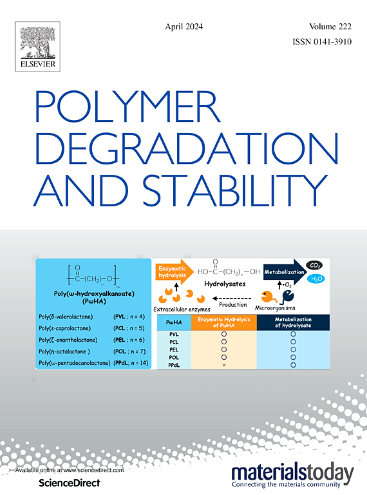A double encapsulation strategy for enhancing the comprehensive performance of PO cable materials
IF 7.4
2区 化学
Q1 POLYMER SCIENCE
引用次数: 0
Abstract
Traditional polyolefin (PO) flame-retardant cable materials face challenges such as low flame-retardant efficiency and poor mechanical properties, particularly when environmentally friendly magnesium hydroxide (MH) is added. Herein, this work presents a novel approach to enhancing flame-retardant PO cable materials through a dual encapsulation strategy for MH. The double-encapsulated MH (HZM) was synthesized by depositing zinc hydroxy stannate, followed by microencapsulation using supramolecular polyphosphazene compounds. The PO composites achieved a V-0 rating with the addition of 56 wt% HZM, whereas the PO materials received no rating with the same loading of pure MH. Combined with the dual advantage of ZHS and supramolecular layer, the peak heat release rate and total heat release of PO-HZM decreased by 71.5% and 36%, respectively. HZM also exhibited outstanding smoke suppression (total smoke, CO2, and CO) of PO composites. Furthermore, compared to PO-MH, the mechanical properties of PO-HZM had been strengthened because of the enhanced compatibility between HZM and PO matrix. Therefore, the double encapsulation of MH offers an effective strategy for developing revolutionary PO cable materials with enhanced comprehensive performance.
提高PO电缆材料综合性能的双封装策略
传统的聚烯烃(PO)阻燃电缆材料面临着阻燃效率低、机械性能差等挑战,特别是在加入环保型氢氧化镁(MH)后。本文提出了一种通过MH双包封策略来增强阻燃性PO电缆材料的新方法。通过沉积羟基锡酸锌,然后使用超分子聚磷腈化合物进行微包封制备双包封MH (HZM)。添加56% HZM的PO复合材料达到了V-0等级,而添加相同纯MH的PO材料没有达到V-0等级。结合zs和超分子层的双重优势,PO-HZM的峰值放热率和总放热率分别降低了71.5%和36%。HZM对总烟、CO2和CO的抑制效果也优于PO复合材料。此外,与PO- mh相比,PO-HZM的力学性能得到了增强,这是由于HZM与PO基体的相容性增强。因此,MH的双重封装为开发综合性能增强的革命性PO电缆材料提供了有效的策略。
本文章由计算机程序翻译,如有差异,请以英文原文为准。
求助全文
约1分钟内获得全文
求助全文
来源期刊

Polymer Degradation and Stability
化学-高分子科学
CiteScore
10.10
自引率
10.20%
发文量
325
审稿时长
23 days
期刊介绍:
Polymer Degradation and Stability deals with the degradation reactions and their control which are a major preoccupation of practitioners of the many and diverse aspects of modern polymer technology.
Deteriorative reactions occur during processing, when polymers are subjected to heat, oxygen and mechanical stress, and during the useful life of the materials when oxygen and sunlight are the most important degradative agencies. In more specialised applications, degradation may be induced by high energy radiation, ozone, atmospheric pollutants, mechanical stress, biological action, hydrolysis and many other influences. The mechanisms of these reactions and stabilisation processes must be understood if the technology and application of polymers are to continue to advance. The reporting of investigations of this kind is therefore a major function of this journal.
However there are also new developments in polymer technology in which degradation processes find positive applications. For example, photodegradable plastics are now available, the recycling of polymeric products will become increasingly important, degradation and combustion studies are involved in the definition of the fire hazards which are associated with polymeric materials and the microelectronics industry is vitally dependent upon polymer degradation in the manufacture of its circuitry. Polymer properties may also be improved by processes like curing and grafting, the chemistry of which can be closely related to that which causes physical deterioration in other circumstances.
 求助内容:
求助内容: 应助结果提醒方式:
应助结果提醒方式:


